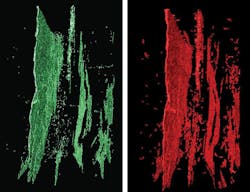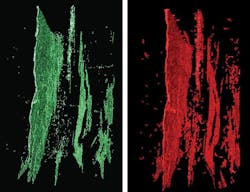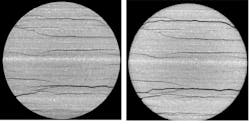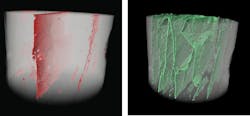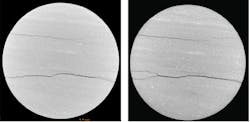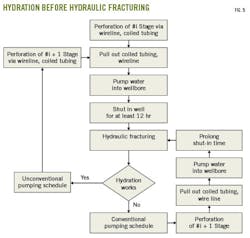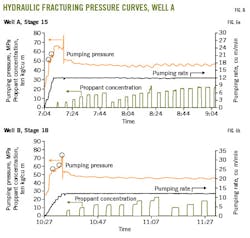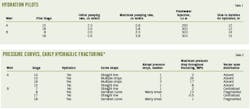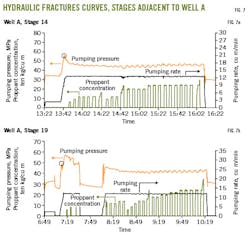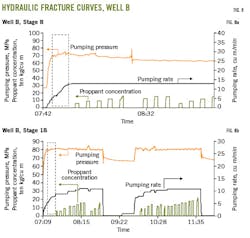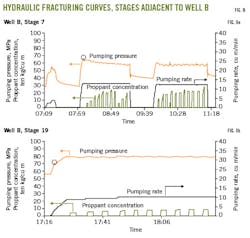Bin Qian
Juhui Zhu
Hai Yang
Xiaozhi Shi
Junlong Li
CNPC Chuanqing Drilling Engineering Co. Ltd. Downhole Service Co.
Chengdu, China
Hydration before hydraulic fracturing improves the connection between pores and natural fractures in the Lower Silurian Longmaxi natural gas shale in China's Zhaotong area in North Yunnan and Guizhou provinces, pilot studies demonstrated. The pilot results confirmed laboratory experiments done using Longmaxi shale core samples. Water enters through microcracks in the natural fracture matrix through capillary self-absorption, propagating primary fractures.
Hydration serves as micro stimulation before hydraulic fracturing. Each shale play must be independently evaluated to determine its potential for hydration. More research is needed into hydration's effect on shale.
Longmaxi shale hydration before hydraulic fracturing induced micro-fractures, promoting rock failure and yielding a more complex fracture network. An increasingly complex fracture network reduces the required pumping pressure and cuts hydraulic fracturing costs.
A CT scan shows Longmaxi shale sample A before hydration (left) and after hydration (right) (Fig. 1).
China's shale gas operators typically use multistage fracturing, pumping 1,000 cu m/min of proppant at nearly 15 cu m/min/stage (OGJ, July 1, 2013, p. 70).
Longmaxi operators currently drill 1,500-m horizontal wells with 24 fracturing stages. Fracturing fluid recovery is sometimes less than 10%. Researchers have studied both how unrecovered fracturing fluid can be imbibed by the shale and the effect of hydration on shale before hydraulic fracturing.1-6
The authors of this article used fresh water to soak shale core samples for spontaneous imbibition in lab experiments and injected stream water into pilot wells.
CT images of shale samples before (left) and after (right) hydration. (Fig. 2).
Experiment results
Experimental samples were divided into three levels of pore-fracture development: not developed, better developed, and best developed. Researchers found the shale cores having better-developed primary pores and natural fractures were strongly affected by hydration, while hydration had the weakest effect on cores with the best-developed pores but no natural fractures.
CT scans of reconstruction of shale samples from Well A before hydration (left) and after hydration (right) (Fig. 3).
Fig. 1 shows hydration increased connectivity between pore throats and fractures by 65% in Sample A, inducing more fracture branches.
Fig. 2 shows fracture width increased as primary fractures propagated along the bedding plane.
The hydration effect's intensity partially depends on how long the Longmaxi shale was hydrated.
CT images of Well B shale sample before hydration (left) and after hydration (right) (Fig. 4).
Researchers ran laboratory experiments both under atmospheric conditions and under a confining pressure of 10 MPa. Samples were injected with fresh water having no additives.
Most pores and natural fractures propagated under hydration, although confining pressure closed some.
Fig. 3 shows hydration's effect on Well A's core samples. Fig. 4 shows hydration's effect on Well B's core samples. The number of pores and natural fractures in all core samples increased to varying degrees under hydration.
Field test results
Field tests of two horizontal wells demonstrated that microfractures were created by hydration rather than by fluid pressure pumping from the surface. Well A is a 1,650-m lateral at nearly 2,260-m vertical depth. It averages 3.5% porosity and 3.4% total organic carbon (TOC).
Well B is a 1,700-m lateral at 2,886-m depth. It averages 3.6% porosity and 5.4% TOC.
Crews injected water in Well A Stages 15 and 18 and in Well B Stages 8 and 18 as a pretreatment before hydraulic fracturing. Researchers evaluated pilot results using surface vector scans and pressure curves.
Fig. 5 shows a flow chart for the pilots. The stage number is represented by i, which stimulation engineers use in computer programming as a cyclic variable. The i stands for any stage hydrated before hydraulic fracturing.
Before hydration, workers perforated a targeted stage using wireline or coiled tubing. They then pulled wireline or coiled tubing from the well to avoid downhole accidents. Workers injected water into the wellbore from a nearby stream.
Experiments done before field testing helped researchers determine an initial pumping rate of 2 cu m/min for Well A and 0.5 cu m /min for Well B. Fresh water's frictional resistance is larger than slick water's resistance. Initial pumping rates can be increased under stable conditions.
Hydration represents forced capillary imbibition rather than spontaneous imbibition. Imbibition yields more fractures, increasing contact between the shale and wellbore for better gas production.
About 10-15% more water was used in hydration pilots than in typical fracturing jobs.
Table 1 lists pumping rates and hydration duration. Pilot wells were shut in for at least 12 hr after hydration. Researchers evaluated the formation's pressure response (pressure curve) during early hydraulic fracturing stages. The pressure response of the hydrated stages was different than the neighboring stages.
Figs. 6-7 show Stages 15 and 18 each demonstrated multiple abrupt pressure drops compared than Stages 14 and 19, which had one each. Abrupt pressure drop indicates rock failure. Hydrated pilots initiated more large-scale fractures than appeared in nonhydrated neighboring stages.
Table 2 shows pressure-curve details during early hydraulic fracturing. Pilot stages experienced more abrupt pressure drops than neighboring stages.
Researchers anticipated no primary large-scale natural fractures or fractured zones for the pilot stages and neighboring stages.
Regarding the maximum abrupt pressure drop, researchers suggest it might stem from the pilots' initiation of multiple fractures. A single fracture dominates neighboring stages during early hydraulic fracturing.
Well B Stages 8 and 18 showed a different pressure response than neighboring stages, as well as distinctions from Well A.
Fig. 8 shows an obvious serrated pressure curve developed in Well B while increasing the pumping rate, indicating an extensive small-scale fracture zone resulting from microfractures triggered by hydration.
The simultaneous propagation of multiple fractures enhanced the hydraulic fracture network for the pilots. Neighboring stages not hydrated before hydraulic fracturing exhibited only one pressure peak as the pumping rate increased.
A sharp pressure drop indicates creation of a large-scale fracture, as it did in Well A pilot stages. But Well B's serrated pressure curve might be attributed to highly-developed bedding structures as well as hydration.
Researchers monitored Well B's hydraulic fracture development using surface vector scanning of microseismic technology. Fig. 9 shows a single hydraulic fracture in Stages 7 and 19.
Vector scans of the pilot fractures exhibited a fragmentized shape with irregular edges while the neighboring stages exhibited a uniform shape with smooth edges. The fragmentized shape has a more complex fracture network although that cannot be attributed entirely to hydration.
Hydration before hydraulic fracturing is a cheaper, easier way to enhance the Longmaxi natural fracture network's complexity than hydraulic fracturing alone.
China National Petroleum Corp. (CNPC) Chuanqing Drilling Engineering Company Co. Ltd. reports a Chinese operator spends about $150,000 for one fracturing stage. CNPC is expected to complete more than 150 Sichuan basin shale wells using hydraulic fracturing during 2018. Authors estimate CNPC could save $13-17 million in the Longmaxi shale by hydrating before fracturing jobs.
Acknowledgment
This work received funding support from the CNPC (2014F47-02) and CNPC Chuanqing Drilling Engineering Company Co. Ltd. (CQ2016B-28-1-4). The authors also thank PetroChina Zhejiang Oilfield Co. for providing the shale cores for the experiments and the wells for the pilots.References:
1. Zhou, Z., Abass, H., Li X., and Teklu, T., "Experimental investigation of the effect of imbibition on shale permeability during hydraulic fracturing," Journal of Natural Gas Science and Engineering, February 2016, Vol. 29, No. 2, pp. 413-430.
2. Yan, Q., Lemanski, C., Karpyn Z. T., and Ayala, L., "Experimental investigation of shale gas production impairment due to fracturing fluid migration during shut-in time," Journal of Natural Gas Science and Engineering, March 2015, Vol. 24, No. 3, pp. 99-105.
3. Qian, B., Zhu, J., Yang, H., Liang, X., Yin, C., Shi, X., Li, D., and Li, J. "Hydration experiments on shale reservoirs plugs," Petroleum Exploration and Development," August 2017, Vol. 44, No. 4, pp. 615-621.
4. Chakraborty, N., Karpyn, Z., Liu S., and Yoon, H. "Permeability evolution of shale during spontaneous imbibition," Journal of Natural Gas Science and Engineering, Vol. 38, No. 2, February 2017, pp. 590-596.
5. Lujun, J., and Geehan, T., "Shale failure around hydraulic fractures in water fracturing of shale gas," Society of Petroleum Engineers Unconventional Resources Conference, Calgary, Nov. 5-7, 2013.
6. Jacobs, T., "Improving shale production through flowback analysis," Journal of Petroleum Technology, Vol. 67, No. 12, December 2015, pp. 37-42.
The authors
Bin Qian ([email protected]) is general manager and engineering professor at Downhole Service Co. within CNPC Chuanqing Drilling Engineering Company Co. Ltd. He holds a BA (1987) from Jianghan Petroleum Institute (Yangtze University) in petroleum engineering and studies novel stimulation technologies and formation damage.
Juhui Zhu ([email protected]) is a senior engineer and director of the stimulation institute at Downhole Service Co. within CNPC Chuanqing Drilling Engineering Company Co. Ltd. He holds MS and PhD degrees from Southwest Petroleum University in petroleum engineering. He studies reservoir stimulation, numerical simulation, and development of unconventional hydrocarbon reservoirs.
Hai Yang ([email protected]) is a stimulation engineer at Downhole Service Co. within CNPC Chuanqing Drilling Engineering Company Co. Ltd. He holds MS and PhD degrees from Southwest Petroleum University in petroleum engineering. He studies hydraulic fracturing, choke management strategy, and formation damage.
Xiaozhi Shi ([email protected]) is a senior engineer at Chuanqing Drilling Engineering Company Co. Ltd. He holds a BA degree from Southwest Petroleum University in petroleum engineering and studies natural gas engineering, hydraulic fracturing technologies, and production-data analysis.
Junlong Li ([email protected]) is a stimulation engineer at Downhole Service Co. within CNPC Chuanqing Drilling Engineering Company Co. Ltd. He holds an MS degree from Southwest Petroleum University in geology. He studies hydraulic fracturing, development of unconventional hydrocarbon reservoirs, and petroleum physics.
